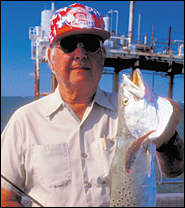|

The coastal fisheries biologists of the new millennium
are working hard to build a bigger, better trout for the 21st century. Here's how you can help them.
By Chester Moore, Jr.
Page 2
Science at work
TPWD fisheries
managers have made great strides in genetic coding of speckled
trout populations. They've determined that trout from the Lower
Laguna Madre can't be stocked in Trinity Bay and vice-versa due
to genetic differences. In fact, genetically unique trout populations
exist between East Galveston Bay and West Galveston Bay.
They've also
made great strides in research methods that have helped to determine
these differences. TPWD coastal fisheries officials now insert
bar code-like tags into the skulls of fish instead of the bulky
gill-plate tags they used to use. These tags stay with the fish
and help the biologists keep track of population dynamics via
electronic technology.
Researchers
at The University of Texas at Port Aransas have learned how to
stimulate growth hormones in the ovaries of trout. And a team
of Louisiana State University scientists have developed methods
for preserving trout sperm so they can perfect trophy-targeted
artificial insemination of the species.
Perhaps what's
most promising is research being done by the Marine Gene Probe
Laboratory in Maryland. They've created pedigrees for certain
species of salmonoids. Aquaculturists are paying top dollar for
salmonoid broodstock that grow extra large, and lab officials
say it won't be long before they can develop pedigrees for other
saltwater species (i.e. speckled trout).
Don't get the
idea that genetics are the answer to everything, though. TPWD
coastal fisheries officials are quick to point out that good genes
may be important for producing big speckled trout, but other factors,
including age, nutrition and environment also play a role.
Incentive for action
 You can't have
huge speckled trout if they're dying before they can get huge.
Good genes can't do anything if the fish all die before they reach
maturity. You can't have
huge speckled trout if they're dying before they can get huge.
Good genes can't do anything if the fish all die before they reach
maturity.
On that note,
Louisiana Department of Wildlife and Fisheries (LDWF) officials
are considering cutting back their daily trout limit from 25 to
10 and raising their minimum size limit to 15 inches from 12 inches.
They're not
planning this move beyond the state's borders, but they are working
with Texas officials to make standardized limits on Sabine Lake,
which is jointly owned by both states.
TPWD Sabine
Lake Ecosystem Leader Jerry Mambretti said LDWF officials are
considering the move to try and create an experimental "trophy
trout fishery." That's a big move from a state that just
recently banned gill nets.
TPWD officials
are getting in on the big trout mania. too. They've created the
"Texas Gulf Coast Roundup," a program modeled after
the ShareLunker program for bass in which coastal anglers donate
live fish for coastal fisheries projects. They're not seeking
speckled trout exclusively, but obtaining top broodstock from
different ecosystems is one of their admitted goals.
These government
agencies may not consciously be working toward the creation of
the super trout, but you can bet they see the potential of such
an accomplishment. The speckled trout is quickly becoming to the
saltwater community what the largemouth bass is to the freshwater
industry, and this is creating a serious economic incentive to
create bigger, better fish.
Do you think
Texas bass fishing would be as popular as it is without the introduction
of the Florida bass? I think not. And along the same note, creating
more large trout would benefit everyone.
The LDWF and
TPWD see this, but they're not the only ones. Mickey Eastman,
founder of the highly successful Gulf Coast Troutmasters, sees
it, and so do all of the tackle and lure manufacturers who are
seeing a serious demand for big speckled trout specific lures
and the rods, reels and line with which to deliver them.
How many Corkys
do you think were sold after Jim Wallace broke the state record
with one back in 1996? Get the picture?
Back at the rig
A month after
my underwater encounter, I found myself at the same rig, but this
time I was armed with some Charlie Slabs, a type of jigging spoon
I've had great success with at oil rigs off of Cameron, La. At
one point I thought I may have hit the jackpot, but found myself
fooled by a small jack crevalle. Feeling the fish hit made my
heart jump, and seeing the flash of the jack's silver scales underwater
nearly caused cardiac arrest, but there would be no trout that
day, "super" or otherwise. And statistically speaking,
I would probably never see such a trout again, neither on my line
nor under the water.
Of course I
never thought I would find myself face-to-face underwater with
the trout of a lifetime in the first place, so you never know
what hand fate is going to deal you. And when science gets in
the mix, the line between fate and progress often gets blurred.
Throw in some
economic incentive for good measure and your chances of seeing the creation
of a super trout in the near future could be better than you ever
dreamed.
The age of
the super trout may not yet be here. But it's probably just around
the corner.
# # # #
page 1 / page 2
| 




